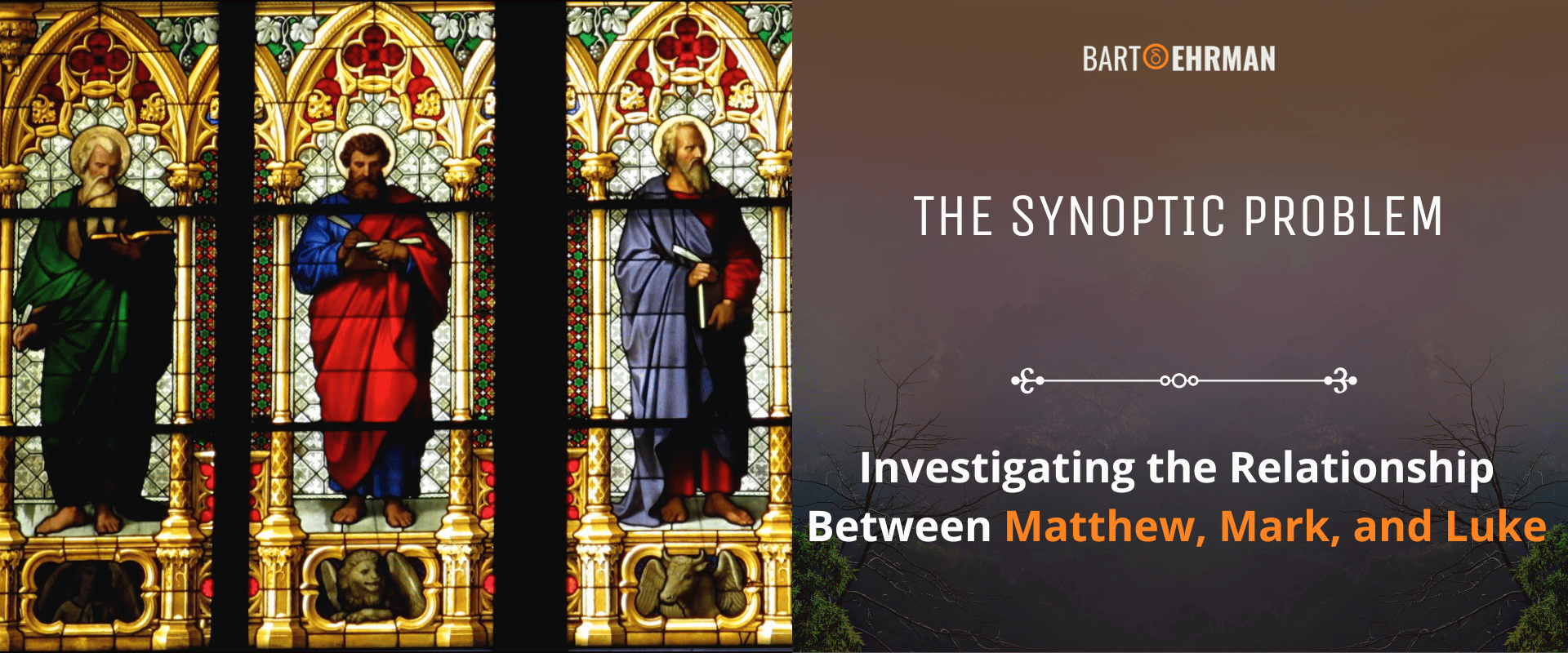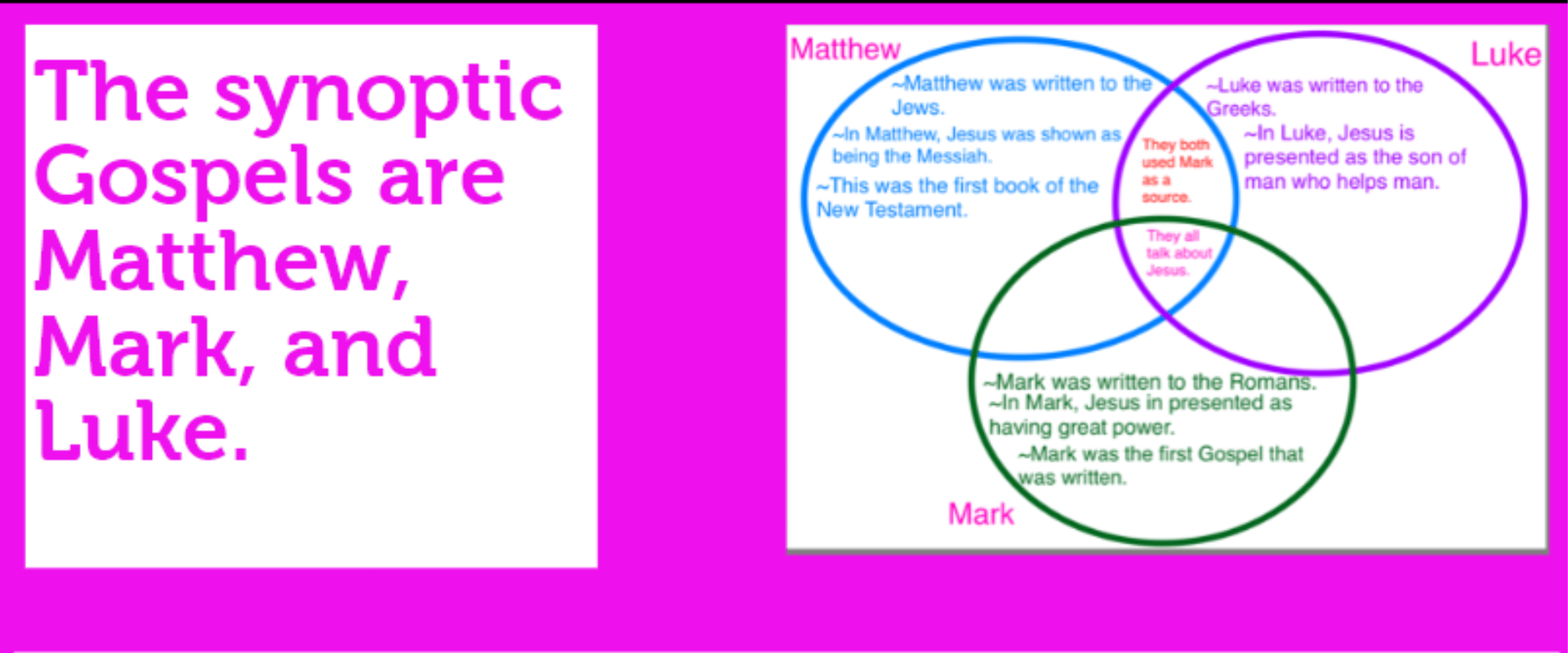The Synoptic Problem: Investigating the Relationship Between Matthew, Mark, and Luke

Written by Joshua Schachterle, Ph.D
Author | Professor | Scholar
Author | Professor | BE Contributor
Verified! See our editorial guidelines
Verified! See our guidelines
Date written: September 15th, 2023
Disclaimer: The views and opinions expressed in this article belong to the author and do not necessarily match my own. - Dr. Bart D. Ehrman
In examining the Gospels, biblical scholars refer to something called the synoptic problem. This is the question of the relation between Matthew, Mark, and Luke, the three synoptic Gospels. What is the synoptic problem? Let’s start by defining it.

The Synoptic Problem Defined
First let’s define synoptic. The word synoptic is derived from a Greek word meaning “seen together.” In many instances, you can put passages from Matthew, Mark, and Luke side by side and they are virtually identical. That is, they can be “seen together.”
Matthew 3:16-17 | Mark 1:10-11 | Luke 3:21-22 |
|---|---|---|
16 And when Jesus had been baptized, just as he came up from the water, suddenly the heavens were opened to him and he saw God’s Spirit descending like a dove and alighting on him. 17 And a voice from the heavens said, “This is my Son, the Beloved, with whom I am well pleased.” | 10 And just as he was coming up out of the water, he saw the heavens torn apart and the Spirit descending like a dove upon him. 11 And a voice came from the heavens, “You are my Son, the Beloved; with you I am well pleased.” | 21 Now when all the people were baptized and when Jesus also had been baptized and was praying, the heaven was opened, 22 and the Holy Spirit descended upon him in bodily form like a dove. And a voice came from heaven, “You are my Son, the Beloved; with you I am well pleased.” |
How much material do the three share? Brent Nongbri writes that Matthew and Luke both contain about 90% of the material in Mark.
The synoptic problem, then, is the question of how these three Gospels relate to each other. Did one of them depend on the other two as sources? Did two of them depend on one? Did they somehow all depend on each other?
The beginning of the Gospel of Luke says “many have undertaken to set down an orderly account of the events that have been fulfilled among us… .” The author’s point is that his version of Jesus’ life is not the first. In fact, he probably made use of the other accounts he mentions.
One of the first questions we need to answer, then, is which of the synoptic Gospels was written first. This will tell us which one could not have used the other two as a source.
Clues: Which Came First?
Brent Nongbri said that Matthew and Luke contain about 90% of Mark. This of course means that they lack about 10% of Mark.
One thing you notice when you look at this 10% is that many Marcan stories - not in Matthew and Luke - are rather strange. Look at this story from Mark 8:22-26, for example:
They came to Bethsaida. Some people brought a blind man to him and begged him to touch him. He took the blind man by the hand and led him out of the village; and when he had put saliva on his eyes and laid his hands on him, he asked him, “Can you see anything?” And the man looked up and said, “I can see people, but they look like trees, walking.” Then Jesus laid his hands on his eyes again; and he looked intently and his sight was restored, and he saw everything clearly. Then he sent him away to his home, saying, “Do not even go into the village.”
It’s an odd story, to say the least. Jesus rubs the blind man’s eyes with saliva, then has to try twice before successfully healing him. It makes Jesus look both odd and not entirely in control. Might this be a good reason to omit this story from later writings?
There is another example in Mark in which Jesus is being arrested in the Garden of Gethsemane. All three gospels contain this incident, but in Mark there is an extra event left out of Matthew and Luke:
A certain young man was following him, wearing nothing but a linen cloth.
They caught hold of him, but he left the linen cloth and ran off naked.
Scholars asked themselves whether it was likely that Mark added these incidents to the accounts in Matthew and Luke. Or is it more likely that Matthew and Luke left them out?
Scholarly consensus says that the second option is more likely. On this basis (among others) most scholars believe that Mark was the first written Gospel (this is called Marcan Priority). This means that Matthew and Luke used Mark as a source.
However, Matthew and Luke also share a lot of material that isn’t in Mark. How do scholars account for the material used by Matthew and Luke but not Mark?
Introducing “Q”: A Lost Source?
Scholars have long assumed that in addition to Mark, Matthew and Luke relied on a second source for their Gospels. Scholars have called this the Q source.
Q is named for the German word Quelle meaning “source.” It was conceived of as an explanation for the material shared by Matthew and Luke but not Mark. Richard Valantasis notes that Q likely began as a set of oral traditions that were later written down. This is still only a hypothesis, of course, since no actual copies of Q survive.
Q consists mostly of sayings attributed to Jesus. If its dates are as early as scholars believe, the earliest level of Jesus traditions are aphorisms rather than stories. Q contains a host of well-known Jesus proverbs, including the following:
Again, it seems unlikely that the author of Mark would have omitted such significant material had he known about it. Matthew and Luke, then, took narratives from Mark and combined them Q material.

Successive Dependence - Did Luke Use Matthew as a Source (or Vice Versa)?
If Mark was written first, then Matthew and Luke had to be written later. Our final question, then, is one of successive dependence. Were Matthew and Luke written independently of each other - known as the “Two Source Hypothesis” - or did one depend on the other as a source?
Scholars who believe in Q’s existence (this is the vast majority) generally think they were written independently. Scholars who don’t believe in Q, such as Mark Goodacre, believe that Luke used Matthew as a source. The scholarly acceptance of Marcan Priority while maintaining that Luke used Matthew is known as the “Farrer Theory.”
Goodacre would argue that certain features in Luke’s Gospel, such as his use of Matthean wording or arrangement of material not found in Mark, suggest direct dependence on Matthew. Goodacre would also point to Luke’s preface possibly implying knowledge of and reference to the Gospel of Matthew.
Another scholar named Alan Garrow promotes a case for Matthew using Luke as a source, known as the “Matthew Conflator Hypothesis.” Garrow has presented a paper and a series of videos explaining the hypothesis, which garnered positive feedback from Richard Bauckham and Chris Tilling, two widely respected biblical scholars. The hypothesis points to various passages in Matthew that seem to show elements of material from Mark and Luke combined. In fact, recently on Bart’s Blog a proponent of Garrow’s arguments became so convinced that he offered $1,000 to charity if anyone could find the holes in Garrow’s arguments. As you can see, it is a fun and intriguing area of study, and many people passionately hold to their theories that solve the synoptic problem.
It is important to note that neither the Farrer Theory or the Matthew Conflator Hypothesis are as widely accepted as the Two-Source Hypothesis, and scholarly debates continue regarding the relationships between the Synoptic Gospels.
Conclusion
What is the synoptic problem? It is the question of the literary relationship between Matthew, Mark, and Luke. The three share so much material, often verbatim, that there has to be some kind of connection between them.
The vast majority of scholars agree that Mark was our first written Gospel (written about 70 CE). They also agree that Matthew and Luke were written later (80-120 CE) and that they used Mark as a source.
In addition, most scholars think Matthew and Luke used another source called Q that is lost to us now. This explains the material shared by Matthew and Luke but absent in Mark.
Q likely began as oral traditions that were eventually written down. We can reconstruct Q by looking at what Matthew and Luke share that is not in Mark.
